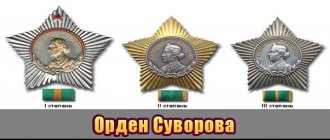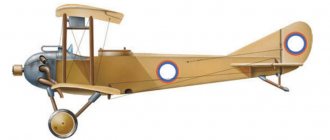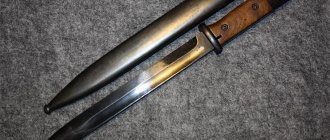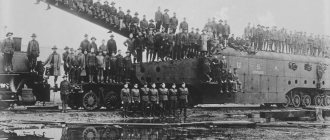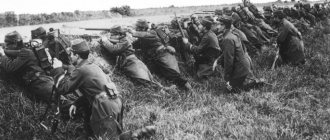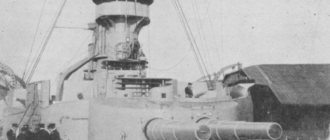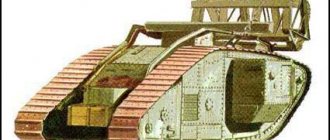Order of St. George and other awards of the First World War
Last year marked one hundred years since the start of the First World War. Our contemporaries know very little about it, but at that time the event was called the “Great” and “Second Patriotic War”. Russian soldiers and officers showed examples of courage and heroism in battles. Many of the military personnel were awarded various insignia. The main and most honorable awards for lower ranks in this bloody war were the St. George Cross and medal.
Order of St. George
The highest award for military personnel in pre-revolutionary Russia was considered the Order of St. George. It was instituted by Catherine the Second at the end of 1769. This insignia was intended to reward officers; only military ranks could become its owner. In addition, it could be awarded for excellent service for at least a quarter of a century in the rank of officer.
After the February events of 1917, General Brusilov allowed the Order to be awarded to soldiers who, replacing commanders killed in battle, took on their functions in battle. To reward soldiers and non-commissioned officers at the beginning of the 19th century, the “St. George Cross” was created, which was respectfully nicknamed by the people “soldier’s George” or “Egory”.
Due to the fact that George is a saint among Christians, persons of other faiths were given a sign, on the obverse of which a double-headed eagle was minted instead. The order had four degrees of distinction. Over the entire period, more than 10,000 military personnel became owners of the order. The first, highest degree was awarded to only 25, including A.V. Suvorov, M.I. Kutuzov, Field Marshals Blucher and Wellington. Among all, only four became full cavaliers, that is, holders of all degrees. 125 military personnel received a second degree.
After October 1917, the Soviet Government abolished the Order. The badge was restored in 2000 and has since been a military award of the Russian Federation. No numbers were assigned to awards; lists of people who received them were compiled. Among others, the badge was distinguished by its statute; it was received exclusively for personal courage in battle and great merit.
Wearing rules
1 tbsp. was a cross with flared ends, covered with white enamel. There is a gold border around the edges. In the central part on a red enamel background is St. George on horseback. He strikes the serpent with a spear. On the reverse is the SG monogram. According to the rules, it was worn on a ribbon over the shoulder. The Order included a star made of gold in the shape of a rhombus.
2 tbsp. - the cross and star are similar to the 1st degree. It should be worn on a 5-centimeter order ribbon around the neck.
3 tbsp. — the cross was the same, but was smaller in size. Worn around the neck, ribbon - 3.2 mm.
4 tbsp. - worn in the buttonhole of a uniform, ribbon width - 22 mm.
St. George's Cross
The insignia of the Military Order, popularly referred to simply as “George,” was created by Alexander the First in 1807 for lower ranks who showed “undaunted courage.” Then there was no division into degrees and each person could receive an unlimited number of awards. Even the generals considered it to be the highest honor to be awarded such a soldier’s cross, because it was awarded for personal heroism. Alexander I personally presented this sign to General Miloradovich.
Since 1855, all recipients were allowed to wear the badge on their uniform. Since 1856, four degrees of award were introduced. The badges of the first and second degrees were gold, the third and fourth were silver. A person was awarded sequentially, first the junior degree, then the senior. But there were exceptions. Holders of all degrees were called full cavaliers.
Before the war, in 1913, a new statute of awards was adopted, which differed slightly from the previous one. From that moment on, their numbering began anew, and the sign officially received the name of the St. George's Cross. Senior degrees were no longer made of pure gold, but with the addition of silver, the reason for this was military difficulties.
For the first time, the fourth degree badge was received on August 1, 1914 by K. F. Kryuchkov. He won the award, defeating almost 30 German cavalrymen. Subsequently, Kryuchkov received the full set, turning out to be a complete gentleman. Women also received “George”, and more than once. It was also awarded to foreigners who served in the Russian army. Among them is the French pilot Alphonse Poiret, who received four crosses.
For heroism shown in the battles of the First World War, the badge was received by:
- 1st degree - 33,000 people;
- 2nd degree - 65,000 people;
- 3rd degree - 289,000 people;
- 4th degree - 1,200,000 people.
After the February events of 1917, it happened that the cross was awarded only for political reasons. In June, the Provisional Government changed the status of the badge and officers could also receive it. This happened by decision of a meeting of soldiers. According to the statute of 1913, the holders of George were entitled to lifelong maintenance. The amount of the incentive depended on the degree.
St. George is depicted on the front side of awards of all degrees. On the reverse is the monogram of St. George. On the reverse side of the sign, a number is engraved on the horizontal ends, and the name of the degree is engraved on the lower end.
There were no awards given during the Civil War. The last Cross was awarded in 1941. This happened in the Russian Corps, which fought on the side of the Nazis on Yugoslav territory.
There are many famous people among the recipients. Vasily Chapaev had three Crosses, Konstantin Rokossovsky had two. Six people were full cavaliers of George and at the same time Heroes of the Soviet Union. Among them is Semyon Mikhailovich Budyonny. In 1992, this badge of honor was restored.
St. George medal
In 1913, on the eve of the war, the St. George Medal was established. It replaced the previously existing medal "For Bravery". She had four degrees, and lower ranks should also have been awarded to her. A badge was awarded for military merits, for which, according to the existing statute, the St. George Cross could not be awarded.
In particular, it could be awarded to civilians who did not belong to the noble class who showed heroism in battle. It was received by orderlies and paramedics who provided assistance to the wounded, risking themselves under a shower of bullets. By analogy with the Cross, the medal had four degrees. The first and second were made of gold, the third and fourth were made of silver. The first and third were distinguished by the presence of a bow.
Since 1916, after a government decree was issued prohibiting the use of precious metals for awards, medals began to be made from “white” and “yellow” metal. On its reverse there were corresponding designations - “f m” or “b m”.
The person who was awarded the medal also received the right to annual payments, which depended on the degree of the award and amounted to 12-36 rubles. The insignia could be awarded to an individual soldier for the feat he accomplished or to any unit.
The medal was located on the uniform to the right of the others and to the left of the St. George Crosses. It was attached to the St. George ribbon. The diameter of the item is 2.8 cm. Since 1913, the obverse of the sign has had a portrait of Nicholas II. In 1917, an image of St. George was placed in its place. On the reverse you could read the words “FOR BRAVERY.” In addition, there was information about the award number and its degree.
There were also signs without a number. They were intended to be presented to women, civilians, and military personnel from the Caucasian and Central Asian regions. During the First World War, awards became truly widespread; servicemen of all branches of the military received medals. Quite often the award was given to nurses.
The medal could be awarded at the same time as the Cross, but the latter was considered a higher award. In addition, the latter was given out for a specific feat. And a certain number of medals were allocated for the military unit, within which they were distributed. Although personal awards were also provided. Until 1917, 1,685,225 awards were minted.
Other Russian military awards
One of the most honorable orders of the Russian Empire is “St. Alexander Nevsky”. It was established by Catherine the First in 1725. This award existed until 1917. The idea of establishing the badge belonged to Peter the Great, who intended to award it exclusively for military services. However, the order was sometimes awarded to civilians. During the First World War, it was awarded frequently; for example, in 1916, 105 people received it. It was restored in 1992.
Nicholas II established a large number of medals. Among them are many memorable ones dedicated to certain dates. The last of them was carried out in 1915 in honor of an excellent mobilization. It was received by persons who took part in the conscription and carried out military transportation.
The Provisional Government left the award system virtually unchanged. They touched only on the images of some royal symbols.
Foreign awards
Not only Russia took part in this war. Most of the world's population was involved in it. Naturally, other countries also awarded their heroes.
The main English military award is the Victoria Cross. It is given to people who have shown courage in battle. The award is presented to military personnel of all ranks and branches of the military. Civilians subordinate to the military command also become holders of the cross.
The appearance of the badge dates back to 1856; it was awarded to participants in the Crimean War. The award is made of bronze. On the obverse there is an image of a lion on a crown. On the reverse is the day, month and year of the event for which the person was awarded. There is a ribbon with the inscription “For Valor”. The product is attached to the uniform with a pin located on the back side of the block. It contains all the details of the award winner.
There is an opinion that all Victoria crosses are made from Russian bronze cannons, which fell to the British after the fall of Sevastopol. But experts question this fact, arguing that many specimens were made from bronze from other sources.
France awarded its heroes the “Order of the Legion of Honor”. The badge was established in 1802 by Napoleon himself, by analogy with the awards of knights. The award is considered the highest honor and respect in this country. The French President is also the Grand Master, and he also receives members. The current work is carried out by the executive apparatus, controlled by the president.
There are several categories of membership. Knights of the Grand Cross are considered the highest. According to the rules, it is impossible to bypass the lowest level, but for special merit this is allowed. The number of members of the order is strictly limited, today there are approximately 93,000 people. This was done so that the prestige of the organization did not fall. About five thousand people are awarded annually, of which only seven receive the highest degree.
The award is also given to foreign citizens, among whom are many of our compatriots. Among them, some Russian emperors were awarded the highest degree. Today this title is held by V.V. Putin.
Military personnel who opposed Russia and the allies also received awards. The main German award is the “Iron Cross”, introduced in 1813. All categories of military personnel could receive it. During the First World War there were four degrees of the sign: second class. First Class, Grand Cross, Star.
The award for services in battle was presented on a black order ribbon with white edging. The Grand Cross could only be received by representatives of the highest German officers. There was also a Badge of Distinction.
By the beginning of the First World War, the German emperor restored the insignia. Military personnel were awarded the Iron Cross en masse. As a result, his highest status was greatly reduced. In total, during this time, approximately five million people became holders of the Cross of the second degree. 218,000 people received the first class award.
In Austria, those who distinguished themselves in battles received the Order of Maria Theresa. It appeared back in 1757 during the Seven Years' War. Although the charter stated that the award could not be given to foreign citizens, there were exceptions. Among them are Suvorov, Kutuzov, awarded the highest degree.
CONTENT
- 1 History 1.1 After World War II
- 1.2 Cold War era
- 1.3 Modern awards
- 2.1 Federal civilian awards
Frequent wear and tear[edit]
| This section may contain original research . |
A common mistake is to wear the German Armed Forces badge (left) as a ribbon on the uniform.
Some awards are given to German soldiers in the form of ribbons, but these cannot currently be worn on the uniform of the German Armed Forces. Examples include:
- European Police Achievement Badge
- Badge of honor for donating blood
- Wearing more than one Life Saving Badge
- Wearing the German Armed Forces badge for military excellence as a ribbon (wearing the badge is permitted).
- Wearing the Presidential Champions Award in the German ribbon format. [5]

